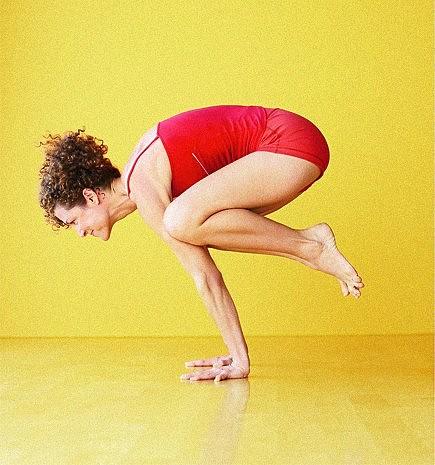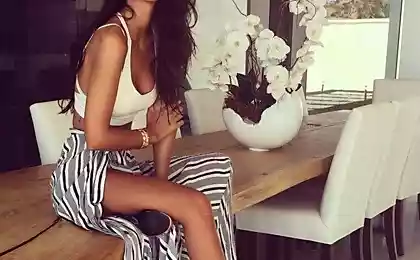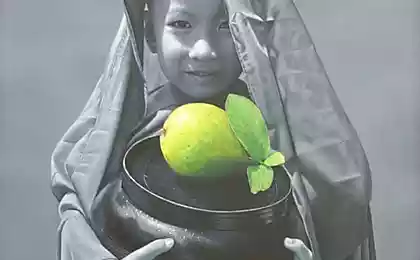755
Sincere practice Urdhva Prazarita Ekapadasany lead you to Santosh -neprivyazannosti and satisfaction.

In the Hindu tradition, the monkey king Hanuman represents the dedicated and selfless service - it jumps across the ocean to the island of Sri Lanka and rescues Sita, wife of Rama.
Considering the practice of yoga as a way to self-improvement, the ancient yoga asanas epic dedicated to the heroes and great sages, hoping that the external form will help them get closer to the inner content. It is believed that Hanumanasana (posture Monkey King) and Urdhva Prazarita Ekapadasana (twine from a standing position) are the postures of spectrum. Both mimic the legendary leap Hanuman, and therefore help to develop his qualities - generosity and loyalty, which in turn lead to the student Santosh - the enduring sense of satisfaction.
In contrast to the posture the Monkey King, a longitudinal twine on the floor, Urdhva Prazarita Ekapadasana - it splits under which one foot is on the ground and the other strives to heaven. Thus, the body is transformed into a metaphor of the "bridge between the worlds" - the material and the divine. And in this sense it does not matter what your stretching. The main thing - it is a sincere decision to enter into the posture and practice it enthusiastically.
Three Principles
Perform this sequence, keep in mind the fundamental principles of Anusara yoga. In each position there are three focus points, one of which is active all the time. It is about the middle of the pelvis, the lower part of the heart and the center of the top of the sky.
Each asana energy expands and contracts and, therefore, has its own special expression. For example, muscle energy connects the body together. It is activated when we contract the muscles to bones, bone - the central line of the body, and when the direct power from the periphery of the body, particularly the legs, to the active focus point. There is also internal energy. Its source - in the middle of the body, it moves from the center to the periphery. It is the energy of expansion, which creates space and freedom.
The inner and outer helix - this type auxiliary energy. If they are balanced against each other, we feel stability and freedom. The inner spiral - a progressive expansion of the proceeding in a spiral from the inside edge of the stop around the feet to the waist. When it is activated, the upper thighs are deployed away from each other. The outer spiral - a progressive narrowing and contraction reaching spiral outward from the outer parts of the waist around the coccyx, pelvis and legs to the feet.
On heating
Before Urdhva Prazarita Ekapadasane, do some preparatory poses to the disclosure of the pelvis and stretching hamstring. Start with Surya Namaskar (Sun Salutation). Hold for a few breaths in Uttanasane (leaning forward from a standing position), leveling legs and pelvis. Take a few transitions from Uttanasany in Malasaña (Garland pose). Perform well Trikonasanu (triangle pose) and Virabhadrasanu I, II, III (pose Warrior I, II, III).
Eka Pada Radzhakapotasana (King pigeons pose with one leg)
This asana opens the pelvis and lower back, lengthening the back of the thighs. Get on all fours on the floor and push your palm. The right foot goes forward, and the left - back. Bend your right leg at the knee to the position of the right angle between the hip and thigh - knee lift off the floor. Pull the toes of the right foot. Do not immerse the right thigh to the floor. Push the floor fingertips of the left foot and lower the left knee to the floor - in this position you will be able to deploy the leg muscles of the inner coil. To the ankle of the right leg bend, relax your toes, pressed tightly against the outside of the foot to the floor, and the outside of the ankle is drawn in. Otherwise, you will not be able to properly disclose the pelvis, and you injure a knee.
Press the tips of the fingers to the floor - it activates the upper body. Extend the inner thighs, sitting bones pointing back and sides from each other. To keep the balance in the position, please send your tailbone toward the floor by activating a spiral around the outside of the right foot. In order not to lose the inner strength, which softens and opens the pelvis, abdomen, and do not let the pelvis to tilt forward. Expand the leg muscles of the inner coil. To enhance the movement of energy in the outer spiral retract tailbone and slowly lower the hips a little lower. If you want to enhance traction, turn left thigh to the floor. Hold the pose for three breath cycles. Return to starting position and do the pose of the left foot.
Hanumanasana (posture Monkey King)
The key to proper implementation of posture is to work hard muscles and pull them to the center of the body as the extension. Get on your knees and pull your right foot forward. Pull the foot, spread your fingers apart from each other and joined in the work the leg muscles. Firmly press the right heel to the floor and push it back, activating hamstring.
Not to relax the muscles of the left leg. To keep it in motion on the inner coil, tuck your fingers. Lean forward, press your fingers to the floor and tighten the muscles of the right leg as far as possible inside. Activating the inner surface of the right thigh, point the right side of the pelvis back - for this you have to deviate slightly to the left. Not relaxing the legs, pull the spine and pull in the coccyx. Bend your elbows and lower sternum and head on the floor. To open the groin and charge it with energy by internal spiral, again deflected to the left, and then pull the leg forward from the very core of the pelvis. Lift your head off the floor and pull up the spine, opening the heart.
Hold the pose for five breaths. Then exit the pose and make it to the other side.
Samakonasana (full cross-splits)
Samakonasana - pose is not simple, and many think it never will not do. Keep in mind that the full version of asanas is largely dependent on the natural flexibility. But people with stiff muscles still need to practice cross-strings, because he is well reveals the groin area.
Sit on the floor in Upavishtha Konasanu (wide-angle position). Pull the muscles of the legs and spread them a little wider. Take a few deep breaths. Helping himself with his hands, tighten the muscles of the thighs inward, away; and then the sitting bones in the back and away from each other. On the exhale, extend your tailbone, feeling that you would like to grow roots into the ground.
Fully extend the legs - from the hips to the toes - and push them to the back surface of the floor. To dissolve legs wider, lower right hand on the floor in front of the pelvis and the left - for the coccyx. Starting hands on the floor, lift your pelvis. Expand the thigh outward, point your tailbone down and lower the hips to the floor. Then dip the tips of the fingers on the floor behind the hips, push them off the floor and extend the side of the chassis, blades retract and open the heart. Push the legs and sit bones to the floor, and the body is extended upward, opening the chest. Stay in the pose for a few breaths. Work legs so not to leave space between the floor and the knees.
Bakasana (Crane Pose)
Bakasana - last pose before Urdhva Prazarita Ekapadasanoy. It prepares the work of his hands. Connect the foot, sit down and spread your knees apart, and then sign in Malasaña. Do not be afraid if your heels come off the floor slightly. Lower hands on the floor, so that the shoulders were on the inside of both legs. On a breath away; his knees away from each other, intensifying the movement of energy along the inner spiral. Lower head and press your knees to your shoulders - it will strengthen the internal spiral. On the exhale, extend your tailbone and send the heels to the floor. Both of these movements will create a movement of energy on the outer spiral. Breathe slowly and deeply revealing pelvis. Next, stand on tiptoe, while continuing to push the knees to the outside shoulder. Pull tailbone and tighten the abdomen. Lean forward and move your weight on the palm. If you can not tear off both feet off the floor at the same time, do it one by one. Balancing in a pose on a breath extend the entire rear surface of the body. On the exhale, soften the heart. Point the tailbone toward the floor. Does this movement from the heart. Straighten your elbows. Connect the foot and bring them to the pelvis.
Urdhva Prazarita Ekapadasana (twine from a standing position)
Sign in Ardha Uttanasanu (half stretching pose). Push the floor fingertips and lift your left leg up high. Stand on the right leg strong. If you feel the balance in the pose, try to embrace the rear surface of the right lower leg with his left hand. In order not to lose your balance, repels the fingertips of his right hand on the floor. Balancing on one leg, imagine that raised left foot pressed against the invisible support as well as the right to the floor. Pull the muscles of both legs, and torso muscles send to the central line of the body. This movement will give you the strength needed to take inner thighs back and away from each other, creating a flow of energy along the inner spiral. Pull the tail bone and imagine that presses to support the left foot (which spins the outer spiral). Tighten your abdominal muscles to the back. Pulls together both legs to the pelvis. Gone inner thighs apart from each other and draw the tailbone as you did in Hanumanasane - this will allow you to strengthen your right foot on the floor and left to pull up high. Pressing the foot to the floor, you gain the strength needed to be drawn up. Try to breathe evenly, softening the excessive rigidity of muscles - otherwise you will feel the tension and will not be able to feel a deep position. Lower the right foot on the floor. Sign in Uttanasanu. Hold slope for several breaths. Then lift up the right foot.
To relax, do the inversions - Sarvangasanu (shoulder stand) Halasanu (Plow pose). Complete practice shavasana (Dead posture).























